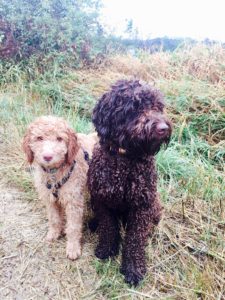Allergies of Australian Labradoodle
Rutland Manor determines hypoallergic success rate of Austrailan Labradoodles as 99%. However if you are struggling with various types of allergies or asthma, the best thing I can advise you it to spend some time with our Labradoodles. In this way, you will see for yourself whether they cause allergic reactions in you or not. I was also very skeptical about that and before I got my first dog I spent with him few hours every few days. During the years Australian Labradoodles were breed selectively in order to be the best service dogs that even allergy sufferers could have. Of course, not all Labradoodles are allergy friendly — but we can be more confident in the case of multi-generation Australian Labradoodles, whose conscious selective breeding was focused on this trait. Going back in time – as the history sais it was hair and saliva that were firstly sent to the laboratory for checking. You must also take into consideration that allergies are not only caused by the hair of the dog. They could be caused by saliva, urine, dead skin and even allergens that could be at the same time on the dogs coat (as pollen). Therefore I always advise and always will advise to visit the breeder and check if the dog does not cause allergic reactions in you. Also please keep in mind that if you have certain allergies (on grass, grains or certain trees) it is better not to try your allergies on Labradoodle during blooming seasons for the above. The reason is that when you get the allergic reaction, first thing you do is to point your finger on the dog – but this does not have to be the case. About 80% of our puppies live with families with heavy asthma or genetic allergies (among them cross allergies with distroyed immune system and bolding). None of the families have allergic reactions on our puppies.
Below I examine briefly the different generations of Labradoodles while concentrating on allergic reactions:
* The first generation (F1) – Labrador and Poodle mix. In the litter of those two there can of course appear a puppy who will be allergy friendly, however it is so uncertain as winning at the lottery. In 2009 at Rutland Manor website it was written “…tests are conducted to determine whether the puppy’s hair texture, could determine the coat of an adult dog if it comes to causing allergic reactions”. And further…”Studies show that there is no direct relation between texture or hair type to allergies.” That means that even if you get a dog (F1) that does not cause allergic reactions for the moment it is unsure that it will not cause the allergic reactions after a year, when he will change his puppy coat to an adult coat. I myself do not advise first generation Labradoodle and especially for allergy sufferers. As it may turn out that our dog must be given away at some point.
* The second generation (F1B) – Cross of a first generation Labradoodle (F1) with Poodle. In this case the result is still uncertain. Note – the second generation is not a mix between F1 and F1.
* Third generation or higher – Cross of the second generation Labradoodle (F1B) with a second generation Labradoodle (F1B). As it was written on Rutland Manor website “to achieve a combination of allergy friendly coat, we must be sure that both parents also had these characteristics. It takes about three generations of selective breeding to get desired results and even then it can happen, that the dog gently sheds (a genetic recessive trait)”.
* Multi-generation Australian Labradoodles. This is one of the best choices if you want a dog that does not shed and does not cause allergic reactions. If both parents do not shed — your puppy should not as well. It takes about three generations of selective breeding to get desired results and even then it may be, however, that the dog gently sheds (a genetic recessive trait). Even then — the dogs coat should not cause allergies.
